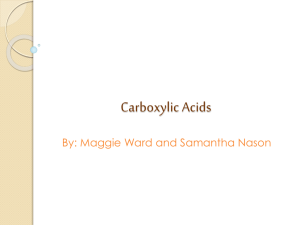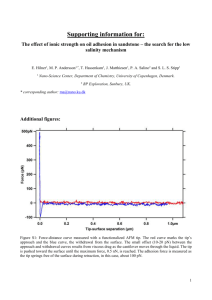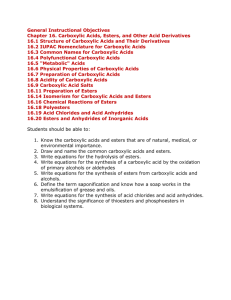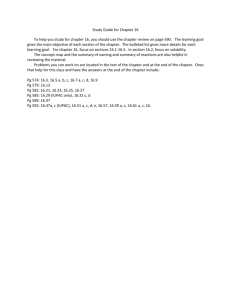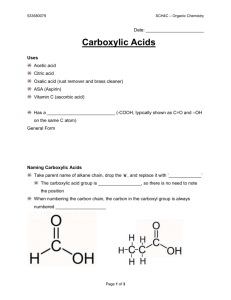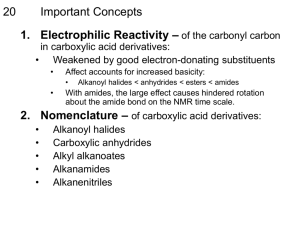GHW#6-Questions
advertisement
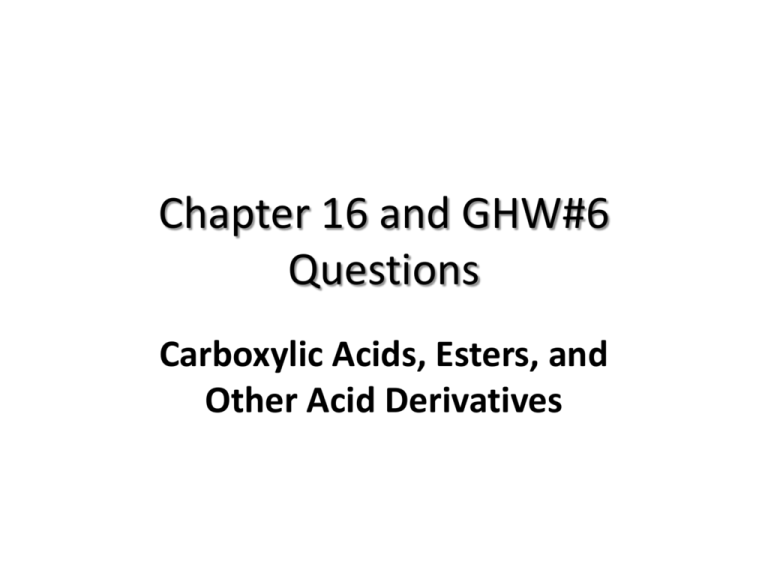
Chapter 16 and GHW#6 Questions Carboxylic Acids, Esters, and Other Acid Derivatives Bonding Characteristics of Carboxylic Acids A carboxylic acid has functional a carboxyl group. A carboxyl group is a carbonyl group (C=O) with a hydroxo group (—OH) bonded to the carboxyl carbon atom. Physical Properties of Carboxylic Acids Both polar molecules and hydrogen bonding makes: BP and MP are higher than alcohols , hydrocarbons and ether with comparable carbon numbers Physical Properties of carboxylic acids derivatives Esters, amides, acid chlorides and acid anhydride have lower boiling and melting points than parent acid, Except Carboxylic Acid Salts IUPAC Nomenclature of Carboxylic Acid and Esters • The IUPAC system deals with functional groups two different ways. • Modification of the hydrocarbon name to indicate the presence of a functional group. • Acid – R-COOH use -oic ending. • Esters –R-COOR’ use -oate ending. Common Names of Carboxylic Acids IUPAC Nomenclature of Carboxylic Acid and Esters Common/IUPAC Nomenclature of Esters 1. Identify the carboxylic acids, esters, amides and acid from the following and give their common and/or IUPAC names. Carboxylic Acids, Esters, and Other Acid Derivatives a)Type:_____________ b) Type:___________________ c)Type:___________________ Name:______________ Name:__________________ Name:__________________ ____ d)Type:____________ e) Type:___________________ f) Type:___________________ Name:______________ Name:__________________ Name:__________________ 1. Identify the carboxylic acids, esters, amides and acid from the following and give their common and/or IUPAC names. Carboxylic Acids, Esters, and Other Acid Derivatives g) h) Type:___________________ Type:___________________ Name:__________________ Name:__________________ i) Type:___________________ Name:__________________ 2. Draw the condensed formula of following carboxylic acid and their derivatives. a) methyl propanoate b) ethyl pentanoate c) propanoyl d) N-methyl chloride propanamide e) N,N-dimethyl f) 2-methyl h) butanoic g) 2(a)pentanamide aminopropan ethanoic ethanamide oic anhydride Polyfunctional Carboxylic Acids • Dicarboxylic acids Oxylic acid Oh my, such great apple pie!" (oxalic, malonic, succinic, glutaric, adipic, pimelic) • "Metabolic" Acids Propionic acid, (C3 mono acids): lactic, glyceric, and pyruvic acids Succinic acid (C4 diacid): fumaric, oxaloacetic, and malic acids Glutaric acid (C5 diacid): a-ketoglutaric and citric acids 3. Identify type and give name of each of the following poly functional carboxylic acids. a) b) c) Type:___________________ Type:________________ Type:__________________ Name:__________________ Name:_______________ Name:_________________ _ d) Type:___________________ e) Type:__________ Name:__________________ Name:________ f) Type:______________ Name:_____________ 3. Give common/IUPAC names of following dicarboxylic acids. Use "Oh my, such great apple pie!" (oxalic, malonic, succinic, glutaric, adipic, pimelic). a) b) c) Common:______________ Common:_____________ Common:_____________ IUPAC:_______________ IUPAC:_______________ IUPAC:_______________ d) Common:_____________ IUPAC:_______________ e) Common:___________ IUPAC:_____________ 3. Give common/IUPAC names of following dicarboxylic acids. f) Name:______________ g) Name:___________ h)Common:___________ IUPAC:_______________ Saturated Fatty Acids • Long chain even carbon atoms C >10 Unsaturated Fatty Acids • Long chain even carbon atoms with C=C bonds 5. Give type/name of following fatty acids, and their derivatives. a) CH3(CH2)10CO2H b) CH3(CH2)14CO2H Type:________________ Name:_______________ Type:________________ Name:_______________ c) CH3(CH2)16CO2H Type:________________ Name:_______________ 5. Give type/name of following fatty acids, and their derivatives. d) H3(CH2)7CH=CH(CH2)7CO2H Type:________________ Name:_______________ e) f) Type:________________ Type:____________________ Name:_______________ Name:___________________ Triglycerides: Triesters of glycerol Preparation of Carboxylic Acids Oxidation of primary alcohol to carboxylic acid (described in reactions of alcohols) Oxidation using Tollen’s basic Ag(NH3)2+ or Bendict’s CuSO4/Na2CO2/Citrate (described in reactions of aldehydes) Oxidation of alkyl side chain of substituted aromatic hydrocarbons (reactions of aromatic alkyl compounds) Hydrolysis of esters. Described in this chaper) Hydrolysis of acid, amides and cholrides etc.. ) Chemical Reactions of Carboxylic Acids Reaction with strong bases to form acid salts (described below in preparation of acid salts) Reaction with strong alcohols to form esters (described below in preparation of esters) Reaction with halogen compounds to form acid chlorides(described below in preparation of acid chloride preparations) Reaction with ammonia and amine compounds to form amides (described in amides chapter 18) Reduction to alcohols with reducing agents (LiAlH4, NaBH4 etc.) 5) Name and complete following reactions a) b) c) d) 5) Name and complete following reactions e) f) 7) Name and complete following reactions. a) Condensation Polymerization b) Aspirin synthesis 7) Name and complete following reactions. c) Cyclic ester formation d) Decarboxylation of b- ketoacids 7) Name and complete following reactions. e) Base hydrolysis of esters f) Base hydrolysis of triglycerides Base hydrolysis of triglycerides Saponification-Soap formation
